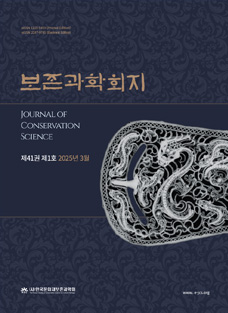Journal of Conservation Science Vol.32 No.4 pp.511-520
고온 XRD 분석법을 이용한 카라테파 불교사원 출토 점토벽돌의 소성온도 추정연구
Estimation Study of Firing Temperature for Fired Clay Brick Relics Excavated from Buddhist Temple in Karatepa Using Analytical Method of High Temperature X‐ray Diffraction
Min Su Han,Jang Jon Lee,Jae Hwan Kim
Abstract
The purpose of this study was to estimate the firing temperature of fired clay brick by applying high temperature X-ray diffraction(XRD) analysis. The clay bricks, which were excavated from a Buddhist temple in Karatepa, Uzbekistan were composed of quartz, plagioclase, alkali feldspar, mica, chlorite, limestone, hornblende, etc. Some clay bricks contained gypsum, which was presumed to have been used to improve the adhesive strength of the brick. Estimating the firing temperature using a geologic thermometer, the UZ-1 sample was identified as being in the quartz, plagioclase,pyroxene series, and the firing temperature was estimated to be 900-1200℃. On the other hand, applying the high temperature XRD method to the UZ-5 sample, it was found that the limestone was destroyed at 1000℃ and the diffraction peak of chlorite was weakened at 1050℃. Moreover, pyroxene series minerals developed at 1050℃ in the reproduction experiment. These results indicate that the clay bricks used in the temple were produced in a kiln that reached a temperature of more than 1000℃. Thus, high temperature XRD analysis can more accurately estimate firing temperatures as compared to the firing temperature mineral identification method and it can be used to determine the creation and extinctiontemperature range of minerals.

 E-Submission
E-Submission 
 E-Submission
E-Submission 
![]() Journal Search Engine
Journal Search Engine




 KSC
KSC